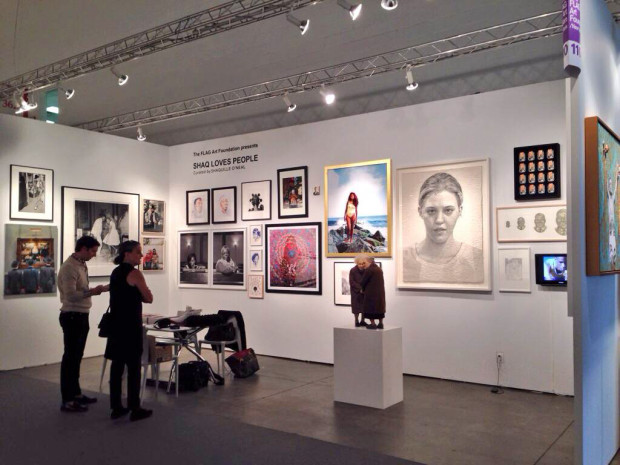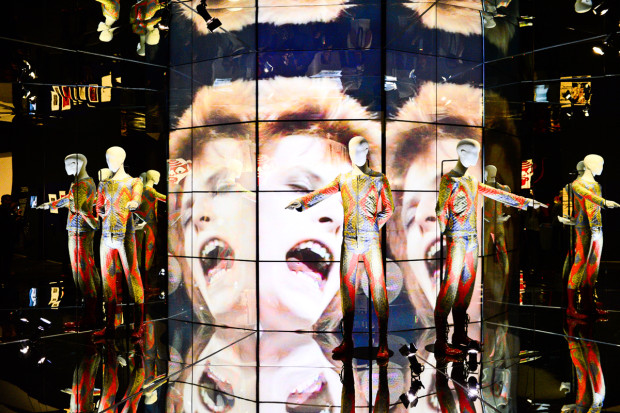CHICAGO – When EXPO Chicago started in 2012, the popular opinion was that President and Director Tony Karman had five years to make this fair great. If he couldn’t, it was likely dead in the water. This weekend marked year three of the midwest fair, and exhibitors and attendees remarked on the palpable momentum. 19 Chicago galleries participated, the highest number yet, and EXPO continued to draw galleries from around the world, including repeat exhibitors like New York’s CRG Gallery who has been on board all three years, and Diana Lowenstein Gallery of Miami, who has been exhibiting at Chicago fairs every year since the 90s.
Thursday night’s VIP Vernissage was well-stocked with local collectors like Linda and Paul Gotskind, Sandra and Jack Guthman, Evelyn and Larry Aronson, and Susan and Lewis Manilow amongst many others. (I know, because in addition to covering the fair for Art F City, I worked as an assistant to EXPO exhibitor Linda Warren Projects). George Lucas, who recently announced his plans to build the Lucas Museum of Narrative Art in Chicago, attempted to keep to himself at opening night, while Shaquille O’Neal surely found the opposite to be true, with an ever-present sea of both art folks and laymen at his elbows. The former NBA star curated the FLAG Art Foundation’s booth; “Shaq Loves People” featured a salon-style, group exhibition of figurative work with some real gems, especially photographs by Dawoud Bey, Malick Sidibé, and Cindy Sherman.
The best booth art to be seen was (not surprisingly) featured by galleries who opted to frame their goods in the way of a curated and/or thematic exhibition. Y Gallery, participating in the EXPOSURE section for young galleries, displayed multiple works by a single artist, Ryan Brown, creating space for viewers to understand the works within the context of his larger oeuvre. Artist Yinka Shonibare contributed a welcome alternative to art fair hegemony, curating James Cohan Gallery booth with works that rely on non-art materials and artists providing a non-western perspective. London’s Hales Gallery booth contained works by Frank Bowling, Hew Locke, Trenton Doyle Hancock, Derrick Adams, and Tom Price, all of whom are black –an exhibition that manages to highlight what the artists share in perspective, as well as do justice to the uniqueness of each practice.
The art at EXPO also thrived in the form of large-scale, site-specific installations. IN/SITU, EXPO’s guest curated entity is organized this year by NY’s Renaud Proch, Executive Director of Independent Curators International. 2013’s IN/SITU was pretty underwhelming, with modestly scaled works by artists like Shinique Smith and Andreas Lolis that, while basically fine in quality, were hardly distinguishable from average booth offerings. This year, spectacle returned with a Chicago-heavy IN/SITU roster that includes a towering, 50-foot cloud of colorful plastic baskets by Jessica Stockholder and two works by Michael Rakowitz, including the politically-charged May the Arrogant Not Prevail, an enormous replica of the ancient Babylonian Ishtar Gate made with contemporary Arabic food packaging and newspapers.
Spectacle continued offsite as well, with venues throughout the city getting in on the action, though to varying degrees of success. The weekend saw the press and VIP previews of the much hyped “David Bowie Is” exhibition, making its only US stop at the Museum of Contemporary Art Chicago. The exhibition, organized by London’s Victoria and Albert Museum, contains only a fraction of the musician’s gigantic personal archive, and beyond granting permission for his property to be exhibited, Bowie personally has no say in the exhibition, nor has he attended either opening. The Chicago version of the show is a strange hiccup in the MCA’s programming, which of late has been consistently intellectual-leaning and very much within our traditional scope of contemporary art. Filled with handwritten lyrics, stage costumes and childhood artifacts, and with hardly any attempts at placing Bowie’s career within a visual art context or linking him to contemporary practices visual or otherwise, it is very difficult to see this one-dimensional exhibition as more than a tactic to get the non-art audience in the doors. (And interestingly enough, Paddy Johnson and Corinna Kirsch said the same thing when they visited the show at the Art Gallery of Ontario last year while covering Art Toronto.)
If the MCA’s “David Bowie Is” is catering to the general public, Rashid Johnson’s performance, The Dutchman, is for an elite few—and those with a strong constitution. The play of the same title, authored by Amiri Baraka in 1964, is reimagined by Johnson, and initially debuted earlier this year in New York with Performa. In honor of EXPO Chicago, the performance found a home for five nights at Red Square Russian and Turkish Baths on Division Street. At the Saturday night performance, my fellow attendees (the majority young, affluent-looking and white) and I were instructed to arrive with our bathing suits at midnight. Wrapped in identical white robes, we entered the sweltering bathhouse sauna to watch two actors, a white woman and a black man, perform the sexually and racially charged play. In the first act, the woman makes campy, fetish-y innuendos towards the man; in the second act, her come-ons turn wildly racist, driving both the woman and the previously-leveled headed man towards physical violence.
As much an endurance piece for the audience as the actors, the sauna’s physically uncomfortable temperature alternately distracts the viewer from the plot at slow points, and becomes secondary to the story at its climactic points. But by far the most potent sensations of Johnson’s piece come after the work is finished, when relief from the heat turned to physical euphoria and the tragic narrative we had just witnessed evaporated into the night air.
Johnson’s piece and the MCA’s show, as well as a huge list of various other concurrent gallery openings, talks and panel discussions, are reflective of the growing event culture that comes with art fairs. Typically they signal the success; within three short years, EXPO has overcome the poor market reputation that was created by the lengthy decline of MMPI’s Art Chicago fair (which closed shortly after the very first EXPO Chicago was announced in 2012).
But at the end of the day, the bottom line of the art fair exhibitors themselves will determine the fair’s future. Exhibiting dealers I spoke to, like Chicago’s Monique Meloche, reported out-of-town curators and museum people making purchases out of the booths, while Pavel Zoubok Gallery spoke highly of the quality of the artwork, the senior dealers involved, and the overall atmosphere’s tendency toward the contemplative, rather than the next “hot thing.”
This is fair standard exhibitor schpiel, but a majority of EXPO’s exhibitors felt certain that this year’s iteration was much better than either previous years, with both foot traffic and sales indicative of a sure and steady forward momentum. Big ticket items were reported sold by David Castillo Gallery (whose booth offered excellent examples by Sanford Biggers, Wendy White and Shinique Smith) and Chicago’s Zolla/Lieberman (who placed a $450,000 Deborah Butterfield). Moving slower this year are the historical works, as Richard Gray Gallery noted far less interest than last year in works like the Picassos and the Warhol for sale in their booth, priced at $750,000.
At Corbett vs Dempsey, I was greeted with contented smiles, as staff described the international collectors and members of the international press that visited and patronized the booth. I asked gallery co-owner Jim Dempsey his opinion on the direction EXPO is heading: whether it’s becoming a fair like all the rest, or it’s stuck with a regional perspective, or it’s still depending on the personality and face-time of Karman himself. Dempsey replied, “It’s like when you’re learning how to ride a bike. You’ve got someone running along side of you, holding you steady. And then at some point, that person gently lets go, and you look back and realize that you’re pedaling on your own.”








Comments on this entry are closed.